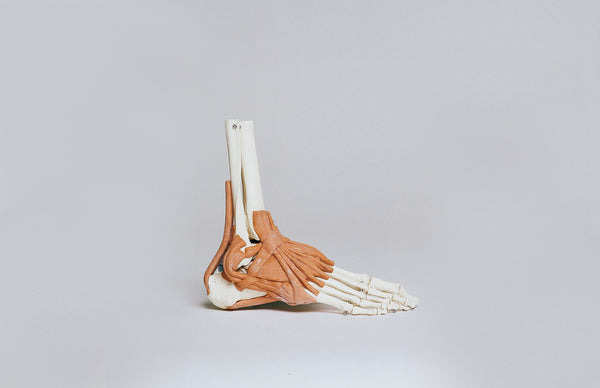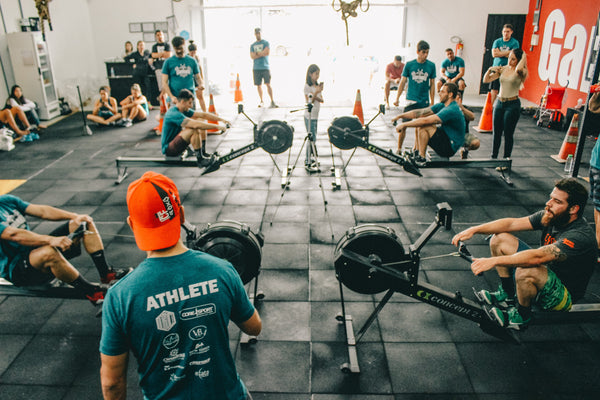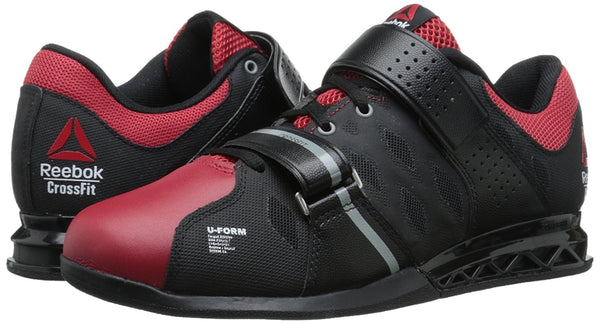- Continue Shopping
- Your Cart is Empty
How CrossFitters Can Avoid or Treat the Pain of Plantar Fasciitis

Anyone who participates in a high-impact workout program like CrossFit understands its risks and rewards. The rewards are both physical and mental – a leaner, stronger body, better cardio health, stronger bones that result from resistance and weight training and greater self-esteem that occurs when difficult challenges are met. On the downside, the risks include injuries to areas of the body that are vulnerable to repetitive stress from all that jumping, running and lifting found in the WODs.
One of the most common repetitive stress injuries for CrossFitters is plantar fasciitis. In nutshell, this an inflammation and degeneration of a thick band of tissue that connects the heel bone to the toes. It is extremely common among those who spends a lot of time on their feet – about 3 million people each year in the U.S. develop plantar fasciitis - but the percentage of athletes with this condition is much higher than non-athletes.
An Ankle and Foot Surgeon Unpacks Plantar Fasciitis
Dr. Christopher Sakowski is an orthopedic surgeon in the Dallas-Fort Worth area who specializes on treating conditions of the ankle and foot. He is also on the referral line of Texas Health Spine & Orthopedic Center. Dr. Sakowski outlines the most common causes of plantar fasciitis.
"It is thought to arise from a biomechanical issue," he said. "Repetitive microtrauma in the region of the plantar fascia (heel of the foot) causes a degeneration of the fibers at the attachment to the calcaneus – the connecting tissues between the heel and toes.
“The term 'fasciitis' is somewhat a misnomer, as it implies inflammation. This condition really this is more of a degenerative condition. Certain mechanical factors such as a flatfoot deformity (or pronation of the foot), which is associated with tight calf muscles, is thought to be a risk factor. Other contributors to the condition include a recent increase in activity, training (or prolonged standing) on a hard surface such as cement or poorly cushioned shoes."

Orthopedic specialists and CrossFit trainers also know that there are often compensatory injuries, since CrossFit fanatics have a tendency to push through their injuries. For example, knee pain that occurs due to a change in gait from a foot injury or pain in the other foot after a chronic injury on the opposite side.
Preventing Plantars: Stretching, Shoes and Orthotics
What can a serious runner or CrossFitter do to avoid getting this injury?
"A good calf stretching program is always recommended prior to any training regimen to help avoid injury," Dr. Sakowski said. "This will also help prevent developing plantar fasciitis. Also, check your shoes regularly to ensure they are well-padded and supportive. Depending on frequency of use, running shoes may need to be replaced as often as every 6 months."
Dedicated CrossFitters understand the importance and the challenge of choosing the correct shoes for a program that has such a wide range of activities – running, weight training, jumping – in a typical WOD.
"I often see my CrossFit patients wearing shoes that are either inappropriate for the activity or shoes that are broken down," noted Dr. Larry Huppin, a Seattle podiatrist.
"Despite the fact that there are many shoes marketed as 'CrossFit Shoes,' there is no one perfect shoe for CrossFit as the activities are just too varied. In fact, theoretically, you should have three types of shoes for CrossFit:
- One pair of shoes for lifting
- One pair for jumping
- One pair for cardiovascular fitness (running)

"However, it is not practical to expect participants to change shoes each time they move from, say, a box jump to a clean and jerk. Thus, it is important to find a shoe that offers the best protection possible for all of these activities.
"Of all of the activities done during CrossFit, weight-lifting is the most technically difficult and the activity that requires the best form in order to prevent injury. So, it is my recommendation that CrossFit athletes focus on getting a very good pair of weight-lifting shoes that also will offer some protection for jumping and cardiovascular activities."
Dr. Huppin, who is himself a CrossFit athlete, recommends several training shoes, and you can get a look and overview of these by clicking here.
Another factor that can help prevent plantar fasciitis in an orthotic shoe insert. Dr. Huppin explains.
"The purpose of any orthotic is to reduce stress on tissue that is prone to injury or is already injured," he said. "For example:
- If a patient is having trouble with plantar fasciitis the goal of an orthotic is to reduce tension on the plantar fascia by limiting arch collapse.
- If a patient is prone to metatarsal stress fractures, the orthotic is prescribed to reduce force through those specific metatarsal bones.
- If a patient is prone to 'runner's knee' or 'jumper's knee' due to excessive foot pronation, the orthotic should function to limit that pronation and help keep the knee in proper alignment."
Treatment for This Condition
"Surgery is very rarely performed for this condition," Dr. Sakowski said. "Initial treatment always focuses on a good home stretching program – both for the calf muscle as well as a plantar fascia-specific stretch. That, in combination with some well-padded gel heel cups, typically alleviates symptoms, although they can persist for many months.
"If these conservative treatments fail and patients are particularly symptomatic in the morning, sometimes using a night splint to keep the foot stretched overnight is helpful. In rare cases, more serious measures are required.
"Although steroid injections can be performed for plantar fasciitis, I try to avoid this if at all possible as they are associated with a significant risk of plantar fascia rupture and typically only last a short time. Platelet-rich plasma (PRP) is becoming a more popular treatment for plantar fasciitis, although there is a lack of good clinic evidence supporting its efficacy. Finally, extracorporeal shock wave therapy (ESWT) is another non-surgical option that has been found to be very effective for recalcitrant plantar fasciitis, if all other treatment options have failed to provide relief."
Have you had to deal with plantar fasciitis in your CrossFit workouts? If so, what worked to get you back in the gym, pain-free? Click here with your story and we will share with our other readers.
Snatching CrossFit Victory from the Jaws of Da Feet (and Ankles)!

When the music is blasting, the box is pulsating and the sweat is flowing, it’s easy to jump into a CrossFit workout with reckless abandon. In fact, that’s the whole idea. However, sometimes that “jump” can cause injuries and it’s difficult to separate minor soreness from potentially major problems. This is particularly true with injuries to the feet and ankles.
Who worries about their feet and ankles? Right?
Sure they get sore when you’re running, jumping and lifting but every other muscle gets sore too. While this is true, it is equally true that the feet and ankles, just as the shoulders and knees, are vulnerable to stress injuries.
Have no fear! With a little knowledge, you can avoid these injuries.
An Ortho Doc Who Understands Why You Are Crazy about Your Workout Most participants in intense CrossFit workouts have experienced the pain of a sprained ankle. While this is a very common injury, the medical explanation of this condition is somewhat more complicated.Dr. Keith Heier is an orthopedic specialist at Texas Health Orthopedic & Spine Center in Carrollton, Texas. In his practice, he has treated hundreds of CrossFit athletes and he has some insights about avoiding injuries to the feet and ankles during one of those grueling WODs.
Most participants in intense CrossFit workouts have experienced the pain of a sprained ankle. While this is a very common injury, the medical explanation of this condition is somewhat more complicated.Dr. Keith Heier is an orthopedic specialist at Texas Health Orthopedic & Spine Center in Carrollton, Texas. In his practice, he has treated hundreds of CrossFit athletes and he has some insights about avoiding injuries to the feet and ankles during one of those grueling WODs.
“There are acute injuries such as sprained ankles and metatarsal fractures, which typically occur when a runner accidentally steps in a hole or off a curb and lands awkwardly, Dr. Heier said. These happen randomly and aside from careful observation, there are very few preventative measures which can be employed.
“There are also injuries which can be prevented among CrossFitters who are just getting started with their program called “overuse” injuries. Muscles can be strained, especially if there is little warm-up, and if the runner doesn’t give this strain the time necessary to heal, the pain and injury will get worse. Overuse injuries can also result from an athlete increasing the length of his/her run before his body is acclimated to the distance,” he noted.
“Genetics can also play a part in these injuries,” he said. “Some CrossFitters have flat feet, high arches, bunions or hammertoes, and these conditions can lead to stress fractures of the metatarsals, tendonitis in the Achilles or planter-fasciitis.
“CrossFit participants are so into their workout that they are more likely to get that overuse injury to their feet or ankles,” Dr. Heier said. “And because the workouts are so intense, these athletes are more likely to get the acute injury. Participating in explosive activities such as flipping tires can easily lead to a tendon tear if the correct form is not used.”
Pushing Through the Pain
Part of the essence of CrossFit training is pushing one’s body to an uncomfortable and even painful level. The standard response for hardcore CrossFitters is to push through that pain. Dr. Heirer explained how an athlete knows when the condition is more than just uncomfortable, and perhaps dangerous for the foot or ankle.
“Any pain that is directly over a bone is a potential problem,” he said. “You can push yourself hard and work through most muscle or hamstring pain, but pain over a bone is NOT something you should work through. Also, pain that is lasting over a week and particular that which is over a bone has the increased likelihood of being a stress fracture. If you notice this type of pain, it’s a good idea to stop the high-intensity workout for a few days and see if the pain subsides. If it doesn’t, it’s time to go an orthopedic doctor to check it out.
“The best way to treat this type of foot or ankle injury is to stop the high-intensity workout and use a milder, aerobic workout on a stationary bike or some very low impact workouts or mild lifting. Once you can feel less pain, you should very slowly get back into regular workout mode. It is easy to re-injure a foot or ankle by returning to a high-intensity regime too quickly. Slow and steady is better. There is a time for tearing down and a time for healing.”
Preventing Feet and Ankle Injuries
Many injuries to the feet and ankles can be avoided by simple, preventative actions. Dr. Heier explained.
“For the CrossFit athlete and serious runner, there are several stretching exercises that can help prevent minor injuries,” he said. “The classic calf stretch involves the runner leaning against the wall and stretching the back of his Achilles tendon.
“A hamstring stretch – where the athlete is bending over and touching her toes – is an easy and effective exercise to do before the workout. It is also advisable to do a planter-fasciitis stretch, which involves pulling one’s ankle back as far as possible and then grabbing the toes back toward the tibia (lower leg). With this stretch, the runner will feel the tightening in the planter-fasciitis part of the foot.
“Finally, simple balance exercises, which help to strengthen the core of the body, are advisable before the run begins. This could be in the form of planks, back extensions or jumping rope.”
Shoes for CrossFit Training

Choosing the right shoe can make huge difference in both the health and fitness success of a runner or CrossFit athlete. According to an article “Men’s Fitness” on choosing the correct shoe for CrossFit training, “Although a regular gym shoe might be good enough for any old workout, you aren't just doing any old workout—you are doing the ultimate workout. So you need a CrossFit shoe that provides stability while lifting, comfort and cushion while sprinting, and secure support for jumps and WODs. Just like you take care of your body while working out to ensure correct form and movement, you've got to take care of your feet, too.” Click here for the MF recommendations for the six best shoes for CrossFit training.
“CrossFit shoes may look great on the outside, but when they have been used for more than 250 miles they present an injury danger to the wearer,” Dr. Heier said. “Wear and tear can cause running shoes to be too tight or too loose. The padding can be worn away and this causes problems.
“My approach to choosing the right shoes involves first examining the type of foot of the athlete. Someone with flat feet should choose a ‘motion control’ shoe with a high arch which helps prevent the flat foot. There is also the classic ‘neutral’ shoe which enhances stability or cushioning. If, for example, someone has a high arch and they choose a shoe designed for a flat foot, this will tilt the runner to the outside of the foot. This could lead to a stress fracture on the outside of the foot.”
Treatment for Foot and Ankle Injuries
As a foot and ankle expert, Dr. Heier treats many serious and casual athletes in his practice. The treatment can range from the very simple, such as rest, or complex, such as surgery.
“In most cases, stopping the running, icing, light stretching and prescribing a nonsteroidal are the first lines of treatment,” he said. “Sometimes our treatment includes changing running shoes or placing an orthotic in the shoe. In rare cases, the injury might require surgery.
“Conditions such as plater-fasciitis, tendonitis of the Achilles and even stress fractures will heal if we give them a chance. Surgery is always the last resort” he concluded.
Check out our Facebook page and post any experiences you’ve have with foot and ankle injuries.




